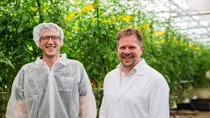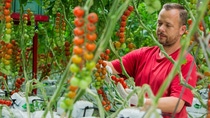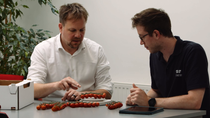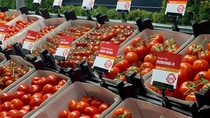Agriculture
Goodbye Food Loss: How The Right Seed Helps Growers to Overcome a Tomato Virus
Imagine you’re a tomato grower looking forward to your next harvest. You are basking in the great development of your plants that you have so carefully nurtured over the past weeks and months – when suddenly, you see it: distorted leaves and brown, wrinkly spots on some of your fruits. Out of nowhere, your worst nightmare has become reality. Tomato Brown Rugose Fruit Virus (ToBRFV) continues to be a disaster for tomato farmers worldwide. Resistant varieties are proving to be the only effective solution.

Christian Zeiler, Managing director and Owner of Zeiler Holding, Austria
Christian Zeiler’s vegetable business was hit in 2021. “In June, we spotted the first weird-looking leaves, and two days later we got the devastating diagnosis from the laboratory. It was an absolute disaster”, the third-generation tomato grower from Austria recalls. “We had to close the farm, throw away of all plants and – worst of all – we had to disappoint our customers.”
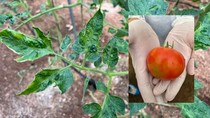
What is ToBRFV?
ToBRFV stands for Tomato Brown Rugose Fruit Virus, a contagious tomato virus which easily spreads via mechanical transmission, making infected fruits unsellable. An infection causes brown and wrinkled patches on the fruits as well as mosaic patterns on and distortions of the leaves. The virus mainly affects tomatoes but can also target peppers. The first occurrence of the new, then unknown virus was first reported in 2015 in Jordan and since then has spread rapidly to the Middle East, Europa, Mexico, North America and other parts of the world. Meanwhile, it has been documented in over 35 countries. Tomatoes are the most consumed vegetable worldwide with some 189 million tons produced globally in 2021. Hence, the economic implications are enormous when entire harvests are lost to the virus.
No protection without resistance
Since 2003, Christian Zeiler has been growing almost exclusively tomatoes at his family farm in Lower Austria, the Austrian Burgenland region and Hungary. All of his locations were subsequently infected with ToBRFV – independently of each other, he stresses, without transmission between the greenhouses. During that summer, Zeiler experienced a stark reminder “that sometimes, despite our best efforts, we must confront the harsh reality that some battles cannot be won.” The insidious nature of ToBRFV has left him with a profound realization: “Once you have it, you will never get rid of it. We cleaned out the entire greenhouses, disinfected everything, replanted the entire lot – only to see symptoms reappear on the newly grown plants after a few weeks.”
For Zeiler, it became painfully clear, that the only protection from ToBRFV lies in resistant varieties. Where no crop protection product is available and strict hygiene protocols can only do so much, they help a lot to put a damper on the destructive force of the tomato virus. Today, Zeiler’s 21 hectares of tomato are exclusively planted with seeds that feature a built-in resistance against the virus.
It was an absolute disaster. We had to close the farm, dispose of all plants and – worst of all – we had to disappoint our customers.
As the aggressive plant virus is easily transmissible, very persistent and difficult to eliminate, resistant seed varieties became the solution of choice to safeguard tomato growers’ harvests and livelihoods – not only for Zeiler, but for growers around the globe facing this same plant disease.
Understand the virus – and join forces to tackle it
BASF started its research on the virus soon after the first incidents were reported in 2015, long before it became evident that tomato growers would soon be dealing with a global problem. Breeding and selection choices are geared towards identifying sources of resistance and developing new and competitive varieties, while many other important traits – size, color, flavor and more – are taken into consideration as well.
A major enabler of this research that provided a quantum leap for the development of resistant varieties was the company’s successful isolation and characterization of the tomato virus. “We were the first company to map the entire DNA sequence of ToBRFV. This discovery provided a completely new basis for research on resistances as it helped to know exactly what we’re up against”, says Geert Janssen, Research & Development Crop Lead Solanaceae Vegetable Seeds. “
That way, this breakthrough research can lead to many more resistant varieties also from other companies, which in the end serve a common purpose: to protect growers’ yields and ensure a reliable and affordable supply of healthy vegetables for a global population.
From greenhouse to table: Vitalion cherry tomatoes resistant to ToBRFV
A new option for high-tech cultivation
A new addition to the BASF portfolio in 2022 is Vitalion, a round cherry tomato variety suitable for high-tech cultivation, bringing the total number of ToBRFV-resistant varieties in BASF’s portfolio up to nine. This new launch also convinced Christian Zeiler in Austria to grow a new tomato this year: “In summer 2023 we sowed BASF’s Vitalion for the first time. Of course, we chose it because of its resistance to ToBRFV, but also because of its great taste, even when grown during the winter months.” Zeiler had carefully studied the results of tests with Vitalion and concluded that the “small, sweet and crunchy” tomato would be a perfect fit for his business philosophy. “I am very happy that seed suppliers like BASF have put so much effort into developing resistant varieties,” he stresses.
Our plant breeders and researchers use innovative breeding practices such as indoor farming and marker technology to accelerate the development process.
And the effort continues: In early 2023, BASF announced that it had more than 20 new ToBRFV resistant varieties in the pipeline to be launched throughout this and the next year. But how is such a rapid and still high-quality output even possible? “Our plant breeders and researchers use innovative breeding practices such as indoor farming and marker technology to accelerate the development process.
That way, the development time for tomato varieties can be reduced to five to six years,” explains Geert Janssen, and emphasizes why this is important: “When a virus as aggressive as this one appears, growers need a solution, and they need it yesterday!”
“For me, it’s no longer an option to use varieties without resistance to ToBRFV. The virus is everywhere. I am glad that breeding companies have recognized this problem early on and succeeded in providing varieties that can better withstand this virus,” concludes tomato grower Christian Zeiler. “We are enthusiastic about our first season with Vitalion and are looking forward to next year, when we will significantly expand our acreage with this particularly tasty snack tomato.”

Published September 28, 2023
For media inquiries or to repurpose the story, please contact:
tanja.rolletter@basf.com or julian.prade@basf.com


